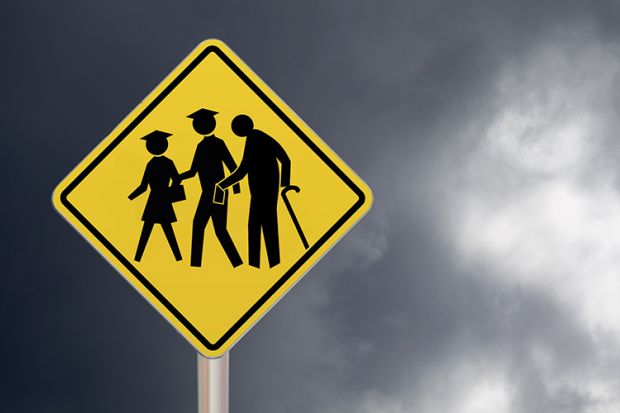Many Americans are concerned about the future of public higher education in the US. Policy experts and researchers have documented how student tuition and fees have been increasingly substituted for state appropriations over recent decades. What has received much less attention is the relationship between rising fees and rising state Medicaid bills.
Medicaid, the public health insurance programme for lower-income Americans, is designed to be operated and match-funded by states. The contribution that states receive from the federal government depends on their poverty levels; California and New Jersey have a 50/50 split, while Mississippi and Arkansas pay only about one-third of their Medicaid costs.
State spending patterns are dramatically influenced by federal incentives. In 1991, spending for public higher education totalled 11.5 per cent of all state spending; by 2020, it had dropped to only 8.5 per cent. That drop might not look dramatic, but bear in mind that 41 per cent of all state spending is federal flow-through: state-administered programmes, from unemployment insurance to transportation, over which states have limited effective control other than whether to take the federal money or not. So their room to make discretionary cuts is limited.
Those three decades saw state funding of Medicaid grow with federal matching funds from $59 billion to $164 billion (£48 billion to £132 billion), a staggering 178 per cent increase. Today, Medicaid constitutes 27.2 per cent of state budgets and in most states is now the largest expenditure category, surpassing even elementary and secondary education – which, for decades, was the largest state funding expenditure.
In 1991, 41 states appropriated more funds for their public higher education operating budgets than for state Medicaid funding. Three decades later, just eight did. Of the other 42, 12 spent twice as much on Medicaid as on public higher education, and six spent four times as much. Particularly alarmingly, in 2021, 25 states spent less on public higher education, in absolute terms, than they did three decades before.
President Lyndon B. Johnson did not even mention Medicaid by name in his 636-page 1971 memoirs, but, by 1995, one in eight Americans was enrolled in the programme. According to the Kaiser Family Foundation, that figure has grown to one in every 3.75 people in 2022. Recent analysis of expenditure data by the University of Alabama’s Education Policy Centre showed that states allocated $105.3 billion of new spending to match federal Medicaid between 1991 and 2020.
How did they find that money? One way was to disinvest in their public higher education operating budgets, leaving tuition and fees, financed largely by student loans, to take up the slack. After all, for state legislators and governors, increasing public college tuition and fees is a low political risk. Public anger about “rising college costs” is deflected to presidents and boards, not opaque Medicaid financing mechanisms.
Hence, since 1991, states have allocated only $10 billion of new state spending for public higher education operating budgets. With nearly 2 million additional students enrolled over that period, the result is that state appropriations per student have declined from $6,375 to $5,148 when adjusted for inflation in 2020.
Higher tuition and fees are, in effect, a tax increase on students and their families. So the shift of spending from higher education to Medicaid amounts to an indirect intergenerational shift in taxation from young people to baby boomers as the highest Medicaid spending per participant category is adults aged 50 and above. And this transfer, far worse than previously documented, and consistent across both Republican and Democratic states, looks set to worsen, with the Census Bureau predicting that Medicaid spending on seniors will increase by 30.3 per cent between 2020 and 2030 and the Department of Health and Human Services projecting that Medicaid spending as a whole will increase by 74 per cent over that decade. An additional $514 billion in annual spending will be required if the 2019 pre-Covid ratio of 63 per cent federal and 37 per cent state matching funds is to be maintained.
The Biden administration’s desire to double Pell Grant awards for low-income students is only a partial solution to the challenge of expanding college access and completion. With a 178 per cent state funding increase in Medicaid since 1991, only federal fiscal incentives through matching funds will motivate states to maintain investments in public higher education operating budgets. The Bipartisan Policy Centre’s January 2020 report A New Course for Higher Education suggested a $5 billion annual federal matching fund was needed to keep college costs down and increase college access and completion.
Such a scheme could move the system away from its dependence on student loan debt, which now totals more than $1.74 trillion, and incentivise states not to bail out of their financing responsibilities to serve the next generation of students seeking a higher education.
F. King Alexander is a professor at Florida Gulf Coast University and a senior faculty fellow in the Education Policy Centre at the University of Alabama. Stephen Katsinas is a professor and director of the Education Policy Centre at the University of Alabama. This article summarises their recent article in the Journal of Education Finance, “The Impact of Federal Funding on State Budget Priorities: Public Higher Education Operating Budgets and Medicaid”. The views presented are those of the authors alone.




